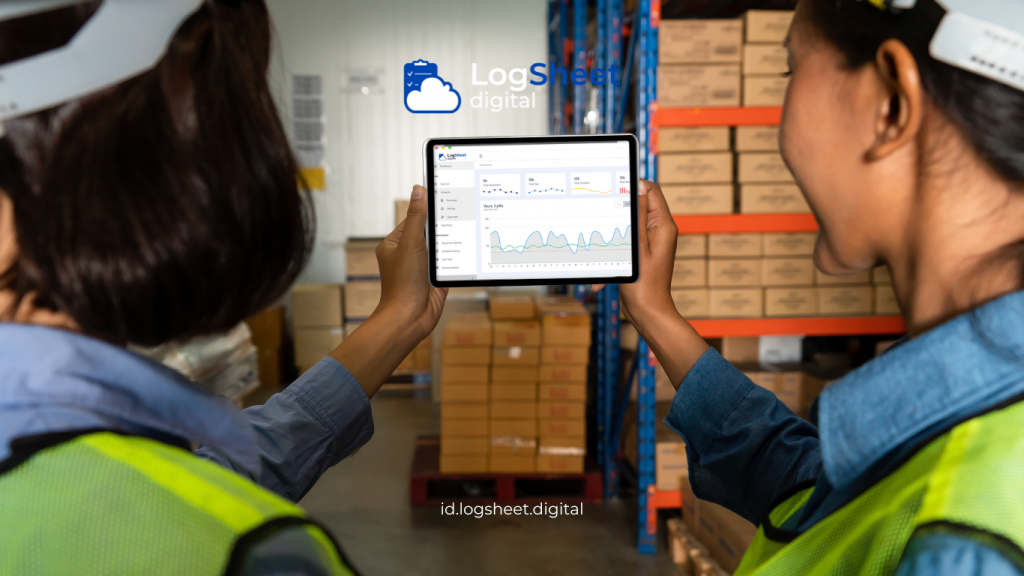In the era of Industry 4.0, companies are required to quickly adapt to technological changes and enhance operational efficiency. One of the increasingly popular innovations is the use of digital logsheets in monitoring industrial operational processes. With its ability to replace often inefficient manual systems, digital logsheets enable companies to record, manage, and analyze data in real-time. This article will discuss the innovation of digital logsheets, their benefits in process monitoring, the challenges that may arise, and the steps for implementation.
What Is a Digital Logsheet?

Read More: Digital Logsheets as Risk Management Tools in Industrial Operations
A digital logsheet is a technology-based recording system used to record and manage data related to operational processes. Unlike manual logsheets, which are often prone to errors and data loss, digital logsheets provide ease of access, processing, and data analysis. Digital logsheets can be accessed through devices such as computers, tablets, or smartphones, allowing for real-time data recording in the field.
Benefits of Digital Logsheet Innovation in Process Monitoring

Read More: Optimizing Operational Supervision Through Digital Logsheets
1. Improved Data Accuracy
One of the main challenges in monitoring operational processes is ensuring data accuracy. Human errors in recording can lead to mistakes in analysis and decision-making. Digital logsheets reduce this risk by providing an automated data recording system. Recorded data can be adjusted to a predetermined format, minimizing the possibility of input errors.
2. Real-Time Data Access
With digital logsheets, information can be accessed in real-time by all stakeholders. This capability allows managers and operational teams to monitor processes directly and make quick, informed decisions based on accurate data. Real-time data access also helps in promptly detecting and addressing issues, reducing potential losses caused by operational problems.
3. Deeper Data Analysis
Digital logsheets not only record data but also allow for deeper analysis. By integrating data from various sources, companies can perform trend analysis, identify patterns, and create more comprehensive reports. This analysis can help companies make strategic decisions to enhance the efficiency and effectiveness of operational processes.
4. Better Performance Monitoring
Digital logsheets enable companies to monitor process performance more effectively. With structured recording, companies can evaluate the performance of each stage in the operational process. This capability helps identify areas needing improvement and allows for appropriate actions to enhance overall performance.
5. Reduced Operational Costs
By improving efficiency and accuracy, digital logsheets can help companies reduce operational costs. This system decreases the time spent on manual recording and data processing, allowing teams to focus on more critical tasks. Additionally, reducing errors in data recording also lowers costs associated with error correction and process repetition.
Steps for Implementing Digital Logsheets

Read More: Digital Transformation: Optimizing Operational Performance with Digital Logsheets
1. Needs Analysis
The first step in implementing digital logsheets is to conduct a needs analysis. Companies need to identify which processes to monitor and what data to record. This will help design digital logsheets tailored to operational needs.
2. Selecting a Digital Logsheet Platform
After identifying needs, companies should choose the appropriate digital logsheet platform. There are various options available in the market, from cloud-based applications to locally installed software. It is essential to select a platform that is user-friendly, integrates with other systems, and meets the company’s specific requirements.
3. Employee Training
For digital logsheets to be used effectively, employee training is crucial. Employees need to understand how to use the digital logsheet platform, from entering data to analyzing the information generated. Proper training will ensure that the entire team can optimize the use of digital logsheets.
4. System Testing
Before full implementation, companies are advised to conduct a system test. This allows companies to identify problems or shortcomings in the system before widespread deployment. Testing also provides an opportunity to gather user feedback and make necessary improvements.
5. Implementation and Evaluation
After successful testing, the next step is to conduct a full implementation of the digital logsheets. Post-implementation, companies need to routinely evaluate the system. This includes monitoring the effectiveness of digital logsheets in enhancing process monitoring and making adjustments as necessary.
Challenges in Implementing Digital Logsheets

Read More: Towards the Future of Operations: The Role of Digital Logsheets
1. Resistance to Change
One of the primary challenges in implementing digital logsheets is resistance to change. Employees accustomed to manual systems may feel reluctant to switch to new technology. Therefore, it is vital for companies to communicate the benefits of digital logsheets and provide support during the transition process.
2. Implementation Costs
Although digital logsheets can reduce operational costs in the long run, the initial costs for implementation can pose a challenge. Companies must be prepared to allocate funds for software, training, and necessary infrastructure.
3. Data Security
With larger data collection and storage, data security becomes a primary concern. Companies must ensure that the digital logsheet platform is equipped with strong security protocols to protect data from cyber threats. This includes the use of encryption, access controls, and activity monitoring to prevent unauthorized access.
Case Study: Implementing Digital Logsheets in the Manufacturing Industry

Read More: Towards Operations 4.0: Industry Transformation with Digital Logsheets
A large manufacturing company decided to implement digital logsheets to monitor their production processes. Previously, they used manual logsheets, which caused numerous errors and delays in data recording. After switching to digital logsheets, the company successfully improved data accuracy and reduced the time needed for recording.
Post-implementation, the company noted a 20% decrease in downtime as equipment issues could be detected earlier. Furthermore, better data analysis allowed the company to identify areas for improvement in the production process, ultimately boosting productivity.
Conclusion

Read More: Enhancing Digital Operations with Logsheets by PT. Nocola IoT Solution at PEPC
The innovation of digital logsheets provides an effective solution for monitoring industrial operational processes. With benefits such as improved data accuracy, real-time access, in-depth analysis, and cost reduction, digital logsheets become essential tools for managing operational efficiency. Despite the challenges in implementation, with proper planning and support, companies can leverage digital logsheets to achieve better operational goals.
As a step toward digital transformation, digital logsheets not only enhance monitoring processes but also support companies in facing modern industrial challenges. By continuously innovating and adapting technology, companies can ensure sustainability and growth in an increasingly competitive market.





leave your comments